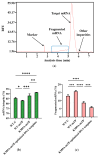Effective Synthesis of High-Integrity mRNA Using In Vitro Transcription
- PMID: 38893337
- PMCID: PMC11173937
- DOI: 10.3390/molecules29112461
Effective Synthesis of High-Integrity mRNA Using In Vitro Transcription
Abstract
mRNA vaccines are entering a period of rapid development. However, their synthesis is still plagued by challenges related to mRNA impurities and fragments (incomplete mRNA). Most impurities of mRNA products transcribed in vitro are mRNA fragments. Only full-length mRNA transcripts containing both a 5'-cap and a 3'-poly(A) structure are viable for in vivo expression. Therefore, RNA fragments are the primary product-related impurities that significantly hinder mRNA efficacy and must be effectively controlled; these species are believed to originate from either mRNA hydrolysis or premature transcriptional termination. In the manufacturing of commercial mRNA vaccines, T7 RNA polymerase-catalyzed in vitro transcription (IVT) synthesis is a well-established method for synthesizing long RNA transcripts. This study identified a pivotal domain on the T7 RNA polymerase that is associated with erroneous mRNA release. By leveraging the advantageous properties of a T7 RNA polymerase mutant and precisely optimized IVT process parameters, we successfully achieved an mRNA integrity exceeding 91%, thereby further unlocking the immense potential of mRNA therapeutics.
Keywords: T7 RNA polymerase; fragmented mRNA; mRNA integrity; mutation; synthesis; transcription.
Conflict of interest statement
Wei He, Xinya Zhang, Yangxiaoyu Zou, Ji Li, Chong Wang and Qiuheng Jin were employed by Vazyme Biotech Co., Ltd. The remaining authors declare that the research was conducted in the absence of any commercial or financial relationships that could be construed as potential conflicts of interest.
Figures












Similar articles
-
An engineered T7 RNA polymerase that produces mRNA free of immunostimulatory byproducts.Nat Biotechnol. 2023 Apr;41(4):560-568. doi: 10.1038/s41587-022-01525-6. Epub 2022 Nov 10. Nat Biotechnol. 2023. PMID: 36357718 Free PMC article.
-
An engineered T7 RNA polymerase for efficient co-transcriptional capping with reduced dsRNA byproducts in mRNA synthesis.Faraday Discuss. 2024 Sep 11;252(0):431-449. doi: 10.1039/d4fd00023d. Faraday Discuss. 2024. PMID: 38832894
-
Exploring the Impact of In Vitro-Transcribed mRNA Impurities on Cellular Responses.Anal Chem. 2024 Nov 5;96(44):17789-17799. doi: 10.1021/acs.analchem.4c04162. Epub 2024 Oct 24. Anal Chem. 2024. PMID: 39445393
-
A review of advances in in vitro RNA preparation by ssRNAP.Int J Biol Macromol. 2025 Apr;304(Pt 2):141002. doi: 10.1016/j.ijbiomac.2025.141002. Epub 2025 Feb 12. Int J Biol Macromol. 2025. PMID: 39952516 Review.
-
The highly efficient T7 RNA polymerase: A wonder macromolecule in biological realm.Int J Biol Macromol. 2018 Oct 15;118(Pt A):49-56. doi: 10.1016/j.ijbiomac.2018.05.198. Epub 2018 May 27. Int J Biol Macromol. 2018. PMID: 29847782 Review.
Cited by
-
Effective Synthesis of mRNA during In Vitro Transcription with Fewer Impurities Produced.Molecules. 2024 Oct 5;29(19):4713. doi: 10.3390/molecules29194713. Molecules. 2024. PMID: 39407643 Free PMC article.
-
Advantages of Broad-Spectrum Influenza mRNA Vaccines and Their Impact on Pulmonary Influenza.Vaccines (Basel). 2024 Dec 7;12(12):1382. doi: 10.3390/vaccines12121382. Vaccines (Basel). 2024. PMID: 39772044 Free PMC article. Review.
References
MeSH terms
Substances
LinkOut - more resources
Full Text Sources
Miscellaneous

